Frogs are amphibians known for their smooth skin, powerful hind legs, and distinctive calls. Found on every continent except Antarctica, frogs thrive in diverse environments ranging from tropical rainforests to arid deserts. They play an essential ecological role by controlling insect populations and serving as indicators of environmental health.
Most frogs have a compact body, with lengths ranging from less than an inch to over a foot, depending on the species. Their permeable skin allows them to absorb oxygen and water, making them highly sensitive to changes in their surroundings. Frogs are carnivorous, feeding primarily on insects, spiders, and small invertebrates. Larger species may even consume small mammals and other amphibians.
During the breeding season, male frogs call to attract females, often congregating near ponds, streams, and wetlands. Females lay hundreds to thousands of eggs in water, which hatch into aquatic tadpoles before undergoing metamorphosis into adult frogs. Frogs rely on moist habitats to survive, although some species have adapted to drier conditions by burrowing or developing specialized skin.
Natural predators of frogs include snakes, birds, fish, and small mammals. However, human-related threats such as habitat destruction, pollution, and climate change have caused significant declines in frog populations worldwide. Conservation efforts focus on habitat protection and reducing chemical pollutants to ensure their survival.

For your safety and the well-being of wildlife, please observe animals from a distance and avoid touching or disturbing them. If you encounter an animal that appears injured or in distress, contact a licensed wildlife rescue organization for guidance before intervening.
Found An Animal? Not sure how to help a wild animal in need? Learn when to step in, who to call, and how to help safely.
Did You Know?
- Some frogs communicate using vibrations, tapping the ground to send signals when calling isn't effective.
- The glass frog has translucent skin, allowing you to see its internal organs.
- Frogs can "drink" through their skin using a specialized patch on their belly and thighs.
- Certain frog species can change color to regulate their body temperature or blend into their surroundings.
- The African bullfrog is one of the few frog species where males protect and care for their young.
- Some frogs secrete mild skin toxins that act as natural antibiotics, helping them heal from injuries.
- The male Darwin’s frog carries its tadpoles in its throat until they fully develop into froglets.
- Some species, like the Surinam toad, carry eggs embedded in their backs, where they hatch directly into young frogs.
- Frog calls are unique to each species, allowing researchers to identify them just by their sound.
Problems Faced In The Wild
- Habitat Loss: Wetland drainage and urban development reduce critical breeding and feeding areas.
- Pollution: Pesticides and chemical runoff contaminate water sources, harming frog populations.
- Climate Change: Shifts in temperature and rainfall patterns disrupt breeding cycles.
- Disease: Chytridiomycosis, a fungal disease, has decimated many amphibian populations worldwide.
- Invasive Species: Non-native predators and competitors can outcompete or prey on native frogs.
- Road Mortality: Frogs are vulnerable to vehicle collisions during migration to breeding sites.
Tips For Cohabitation
- Preserve Wetlands: Support conservation efforts to protect ponds, streams, and other natural water sources.
- Reduce Chemical Use: Minimize the use of pesticides and fertilizers that can contaminate waterways.
- Create Frog-Friendly Habitats: Build small ponds or leave natural water sources in your yard.
- Keep Pets Away: Domestic animals can disturb or harm frogs, especially during breeding season.
- Provide Native Vegetation: Planting native plants creates shelter and attracts insects for frogs to eat.
- Educate the Community: Share the importance of frogs in controlling insect populations and maintaining healthy ecosystems.



